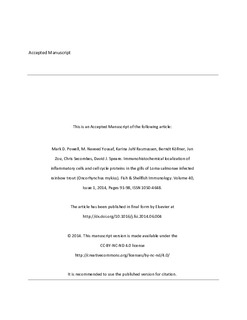Immunohistochemical localization of inflammatory cells and cell cycle proteins in the gills of Loma salmonae infected rainbow trout (Oncorhynchus mykiss)
Powell, Mark Darryn; Yousah, Muhammed Naveed; Rasmussen, Karina Juhl; Köllner, Berndt; Zou, Jun; Secombes, Chris; Speare, David J.
Journal article, Peer reviewed
Accepted version

Åpne
Permanent lenke
http://hdl.handle.net/11250/2574119Utgivelsesdato
2014Metadata
Vis full innførselSamlinger
Originalversjon
Powell, M. D., Yousaf, M. N., Rasmussen, K. J., Köllner, B., Zou, J., Secombes, C. & Speare, D. J. (2014). Immunohistochemical localization of inflammatory cells and cell cycle proteins in the gills of Loma salmonae infected rainbow trout (Onchorhynchus mykiss). Fish & Shellfish Immunology, 40(1), 91-98. doi: 10.1016/j.fsi.2014.06.004Sammendrag
Microsporidial gill diseases particularly those caused by Loma salmonae incur significant economic losses to the salmonid aquaculture industry. The gill responses to infection include the formation of xenomas and the acute hyperplastic inflammatory responses once the xenomas rupture releasing infective spores. The aim of this work was to characterize the inflammatory responses of the gill to both the presence of the xenomas as well as the hyperplasia associated with L. salmonae infection in the rainbow trout gill following an experimental infection using immunohistochemistry. Hyperplastic lesions demonstrated numerous cells expressing PCNA as well as an apparent increased expression of caspase-3 and number of apoptotic cells (TUNEL positive cells). There was an expression of TNFα in individual cells within the gill and increased expression of a myeloid cell line antigen indicating the presence of granulocyte infiltration of both the hyperplastic lesions as well as the xenomas. Similar immune-reactivity was seen in gill EGCs. Hyperplastic gill lesions showed a marked infiltration of CD8+ cells and expression of MHC class I antigens. These findings suggest that L. salmonae xenomas may be subject to infiltration by the host immune cells as well as the mounting or a marked cellular cytotoxic immunoreaction in the resultant hyperplasia following xenoma rupture and spore release.
Beskrivelse
Author's accepted version (post-print).
